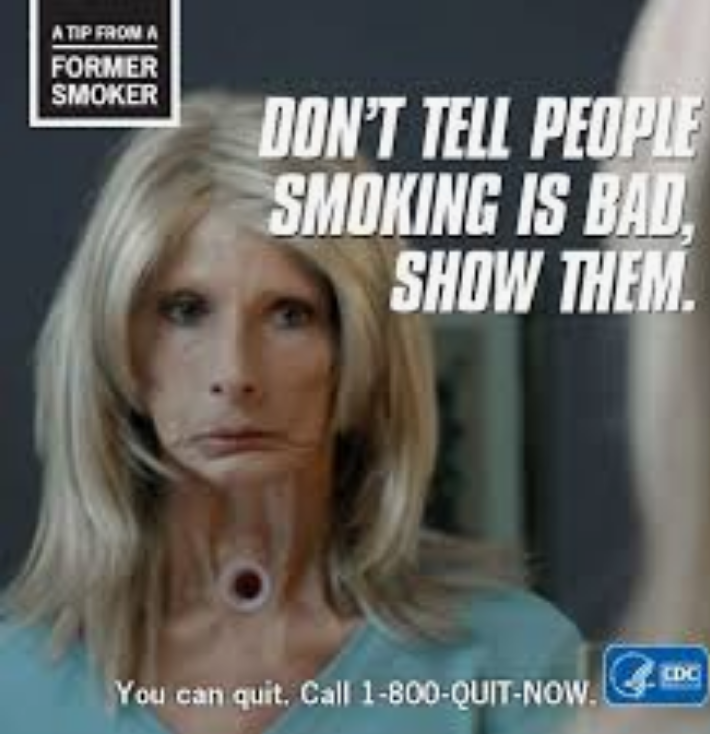Ethics in health promotion
 When looking at the ethics of health promotion we can look at several different concerns. First, there is the stigmatization of people with a certain behaviour or health problem. Second, there is the way health promotion campaigns are run - for example, the use of fear campaigns. Third, there is the question of using children in health campaign research. Finally, as technology is being used more frequently to gather data during health campaigns, privacy must be considered.
When looking at the ethics of health promotion we can look at several different concerns. First, there is the stigmatization of people with a certain behaviour or health problem. Second, there is the way health promotion campaigns are run - for example, the use of fear campaigns. Third, there is the question of using children in health campaign research. Finally, as technology is being used more frequently to gather data during health campaigns, privacy must be considered.
However, when looking at health promotion, it is most important that whatever treatment is being recommended, that there be equal access for all members of a population. This concept is known as equity.
Equity
One of the criticisms of many health campaigns is that they focus on an individual's personal choices in health; however, for many people, the reason for their poor health behaviors is not because they don't want to make healthy choices, but that there are barriers to their ability to make those choices. Those barriers may include a lack of access to health care, financial limitations that make it difficult to purchase healthier foods or living in a neighborhood where crime or air pollution may limit options for outdoor exercise.
A concern for health psychologists is that health promotion interventions may benefit mainly those who are better off socially and economically. This includes various health issues, including cancer, heart disease, and breastfeeding.
Providing solutions to barriers is a central guiding principle in social marketing and highly relevant to considerations of equity.
Chapman & Mackenzie (2012) criticize many anti-smoking campaigns that focus on the use of different treatments to stop smoking, without letting people know that they could also "just stop" - what is called "unassisted cessation." The researchers argue that clinical smoking cessation programs have been presented by healthcare professionals as the most effective means for smoking cessation compared to unassisted smoking cessation. However, they posit that this information could be both ineffective and harmful when promoted to economically disadvantaged populations because the medical products are inaccessible to them and it could discourage personal efforts. Often campaigns that promote nicotine replacement therapy (NRT) make claims like, "It's very hard to quit. You have probably tried before and failed." In addition to not helping those that cannot afford the treatment, this also may lead to feelings of inadequacy in the population. Instead, the researchers argue that it should be communicated that before the treatment, people were able to stop smoking as well.
Critical thinking: Menu labeling
 Another example that demonstrates issues of equity as they relate to the ability to realize health information concerns menu labeling. Menu labeling is when restaurants are required to display standardised information about the nutrient content of food and beverages in a readily available, clearly visible format at the point of sale, to inform people’s purchasing and consumption decisions. Researchers argue that menu labeling may preferentially influence the welfare of those who are healthier and wealthier and have the opportunity to make choices. An additional ethical concern is that focusing the responsibility on people to make choices might shift the focus away from the institutional changes needed for people to be able to make healthier choices.
Another example that demonstrates issues of equity as they relate to the ability to realize health information concerns menu labeling. Menu labeling is when restaurants are required to display standardised information about the nutrient content of food and beverages in a readily available, clearly visible format at the point of sale, to inform people’s purchasing and consumption decisions. Researchers argue that menu labeling may preferentially influence the welfare of those who are healthier and wealthier and have the opportunity to make choices. An additional ethical concern is that focusing the responsibility on people to make choices might shift the focus away from the institutional changes needed for people to be able to make healthier choices.
Discussion questions
1. Do you think that this is a clear example of inequity? Why or why not?
2. What could restaurants change in order to help people make healthier choices?
3. Can you think of other examples where health programs may be targeted for people who are already advantaged in society?
1. Do you think that this is a clear example of inequity? Why or why not?
It sort of depends on the restaurant. Simply labeling food on a restaurant menu is not enough, if there are not healthy options on the menu. More highly educated people will potentially benefit more from this strategy if there is not enough information provided. For example, simply knowing how many calories are in a meal is not enough to make a decision. People should know the recommended number of calories per day for men (2500) and women (2000). Without such background information, the numbers are not very informative. This strategy may be an example of inequity, but there are ways that this could be addressed.
2. What could restaurants change in order to help people make healthier choices?
Their advertising could focus on healthier options. They could also offer free samples of the healthier options (taste testing, amuse-bouche) in order to help promote them. In addition to calories, including the amount of sugar or fat would also be helpful information. This doesn't need to be done on the menu itself, but having a webpage devoted to the nutritional value of their menu would allow concerned consumers to check this information. The other option is to consider where the healthy food is placed on the menu. Is it central to the menu? At the beginning of the menu? Or is it placed at the end of the menu or have a discouraging heading - e.g. Concerned about your weight?
3. Can you think of other examples where health programs may be targeted for people who are already advantaged in society?
Think about the sun cream ad. This ad featured middle and upper-class children talking about their holidays. This ad is a good example of how health programs are often targeted at those that are already advantaged.
International mindedness: The question of vaccinations
 One of the difficult questions in the ethics of health promotion is the importance of individual autonomy vs the health of the larger community.
One of the difficult questions in the ethics of health promotion is the importance of individual autonomy vs the health of the larger community.
Some people, because of religious or cultural beliefs, are against the vaccination of children. In some cases, it is because of disinformation regarding the link between vaccinations and other health problems - such as autism.
And yet, failure to get vaccinated for diseases such as measles has led to public health problems where immunocompromised individuals may get the disease. What do you think is the best solution to this ethical dilemma?
With the Coronavirus, this issue has become even more relevant than when I originally wrote this chapter! After having students share their own ideas, you may want to give them the following article: Key Actions to Promote Vaccine Acceptance. The article explains the Salzburg Statement on Vaccine Acceptance as a strategy for educating people on the safety and importance of vaccinations.
Stigmatization
The most fundamental ethical consideration is "no undue stress or harm." However, as a result of health promotion campaigns, some people might become particularly anxious because they do not feel empowered to avoid health problems. In addition, campaigns might inadvertently stigmatize certain groups.
Obesity prevention campaigns run the risk of stigmatizing people who are overweight or obese. As a result of such campaigns, people who are overweight may view themselves more negatively, leading to feelings of disempowerment. More significantly, those that are not overweight may assume that those who are obese lack willpower or character - and not recognize the role that economic, social, genetic, and psychological factors play in diet and body weight. Those with healthy body weights may then end up blaming the victim rather than seeking out ways to provide support for those who need it. People should not be blamed for not being responsible if they do not have the capacity to make what society considers responsible choices.
 Wang (1998) has argued that even though an ad may be effective, it may still lead to stigmatization. For example, an ad that showed people in a wheelchair as a result of drunk driving (or being in the car with someone who drove while under the influence of alcohol) had a major effect on people that watched it. However, people with disabilities may then be seen as having played a role in their own disability. This illusory correlation then may affect the self-esteem and dignity of people living with disabilities.
Wang (1998) has argued that even though an ad may be effective, it may still lead to stigmatization. For example, an ad that showed people in a wheelchair as a result of drunk driving (or being in the car with someone who drove while under the influence of alcohol) had a major effect on people that watched it. However, people with disabilities may then be seen as having played a role in their own disability. This illusory correlation then may affect the self-esteem and dignity of people living with disabilities.
Stigma in obesity campaigns
The video below looks at an anti-obesity campaign that went wrong. Watch the video, making note of the criticisms of the campaign.
If you were going to run an anti-obesity campaign, what would be your guidelines for coming up with the campaign? How would you design it in a way that was informative, equitable, and avoided stigmatizing those that struggle with their weight?
This is a rather complex question and there are no "correct" answers. Some students may argue that the ad campaign was not offensive and that people are overreacting. Obesity is particularly difficult to address as in some countries this has become a cultural norm.
The issue of "fat-shaming" or "body-shaming" is very much part of the modern discourse in psychology. You may want to have your students read this debate about how we should or should not be addressing the question of obesity.
One of the suggestions is that doctors should be better trained in how to have discussions with their patients about their weight. This should not be seen as fat-shaming but as part of the routine check-up. Many doctors address the question indirectly by referring to the need for "lifestyle changes" rather than identifying one's weight specifically as a problem. there are several studies on this - for example, Swift et al (2013).
Fear arousal campaigns
An ethical consideration that is often overlooked in the discussion of health promotion campaigns is consent. Many health campaigns will be shared with the public while they watch television or as they surf the Internet. Especially in the case of fear arousal campaigns, this may be a concern - especially when the campaign makes use of graphic or provocative images to influence the viewer.
The "hooked" ad
As part of the NHS's anti-smoking drive, this television, press, internet and poster ad campaign showed smokers having a fish hook pulled through their cheek, representing their craving for cigarettes.
Warning: The following video may be found to be disturbing.
Do you think that the message outweighs the concern about its graphic nature?
Many of those who complained said the adverts were offensive, frightening and distressing. The largest group of complaints related to the effect the ad could have on children.
Research in psychology: McAffee et al (2013)
 McAffee et al (2013) wanted to test the effectiveness of the "Tips from a former smoker" campaign, in which viewers watch a woman get ready for her day, who had had throat surgery as a result of smoking. 3051 smokers and 2220 non-smokers completed questionnaires prior to and after the campaign was aired. 2395 (78%) smokers and 1632 (74%) non-smokers recalled seeing at least one Tips advertisement on television during the 3-month campaign. Quit attempts among smokers rose about 12%. Nationally, an estimated 1.64 million additional smokers made a quit attempt, and 220 000 remained abstinent at follow-up. The prevalence of people talking with friends and family about the dangers of smoking showed an increase of 4.7 million additional non-smokers recommending cessation services and more than 6 million talking about the dangers of smoking.
McAffee et al (2013) wanted to test the effectiveness of the "Tips from a former smoker" campaign, in which viewers watch a woman get ready for her day, who had had throat surgery as a result of smoking. 3051 smokers and 2220 non-smokers completed questionnaires prior to and after the campaign was aired. 2395 (78%) smokers and 1632 (74%) non-smokers recalled seeing at least one Tips advertisement on television during the 3-month campaign. Quit attempts among smokers rose about 12%. Nationally, an estimated 1.64 million additional smokers made a quit attempt, and 220 000 remained abstinent at follow-up. The prevalence of people talking with friends and family about the dangers of smoking showed an increase of 4.7 million additional non-smokers recommending cessation services and more than 6 million talking about the dangers of smoking.
Children and health promotion
As noted above, one of the key concerns in fear-arousal campaigns is when children see graphic images. But another way in which children may be affected is when campaigns do "pilot programs" in communities to test the efficacy of one type of health intervention over another. In addition to the need for informed consent from the parents, such experiments often have a control group that doesn't receive a program that is believed to be helpful. The study below is not unethical, but there are ethical considerations when it comes to the use of children in the study.
Research in psychology: Lowe et al (2004)
Lowe et al (2004) investigated the potential role of social cognitive theory in promoting healthy eating in British school children - with the specific goal of increasing the consumption of fruits and vegetables.
The sample was made up of 749 children, aged 5 - 11 years old, in two inner-city London primary schools. One school served as a control; the other school underwent the experimental intervention known as the Food Dudes Program.
At the start of the study, the level of fruit and vegetable consumption was measured in order to establish a baseline. To establish this baseline, the researchers used three key measures. First, children in both schools were given the option of consuming fruit and vegetables at lunchtime. Their choice of foods was observed and recorded on a five-point rating scale. In addition, the younger children (ages 5 - 7) received fruit at snack time. The weight of the fruit consumed was recorded. Finally, questionnaires were given to their parents, asking them to recall the eating behaviours of their children. Consumption levels would again be measured during the intervention and four months after the completion of the program.
Over 16 days children watched video adventures featuring the Food Dudes. The Food Dudes are young superheroes who are involved in saving the world from the “Junk Punks,” who plot to take destroy the world by depriving it of fruit and vegetables - and thus, its key energy force. The Food Dudes not only continue to beat the “Junk Punks,” but they are seen eating a range of fruit and veg, explaining how wonderful they taste - and showing that they are the key to their power in defeating the bad guys. This is an important part of social cognitive theory - giving the children models whose behaviour they may imitate.
After watching the six-minute videos, teachers read aloud a letter “from the Food Dudes” to the students. The letters explained the need to fight the Junk Punks, the benefits of eating a healthy diet, and gave information about prizes for eating well. In addition, the children were given a “Food Dudes’ Home Pack” which encouraged them to eat more fruit and vegetables at home - and having their parents record what they were eating. This is the second important part of the social cognitive theory - helping the children to develop a sense of self-efficacy - explaining to them that they can “help,” and then giving them a plan to do so.
After 16 days, there were no more videos and the rewards for eating these foods were less frequent.
The researchers found a significant increase in fruit and vegetable consumption both at school and at home among children in the experimental condition. The greatest increase was seen in the children who at the beginning of the study had shown the lowest consumption rates of fruit and vegetables. For example, during snack time, these children went from eating just 4% of the fruit they were given, to eating 68% of it after watching the Food Dudes series. Four months later, they were still eating twelve times as much fruit as they had originally, and four times the quantity of vegetables. In the control school, where the same fruit and vegetables were offered to students, but without the Food Dudes intervention, there was no change in their interest in consumption rates.
Privacy
A final consideration, which has become even more relevant in the era of technology, is privacy. Activity trackers such as Fitbit have become a common way to help people manage their exercise plans and promote their fitness. However, using such personalized digital devices typically means disclosing personalized information on one’s activities, preferences, weight, food and alcohol consumption, and even relationships. This raises issues regarding respect for privacy. Who has access to this data? Critics argue that this data can be used by corporations and government agencies for monitoring or commercial purposes. And yet - having such data may give governments a sense of how well a campaign may be working - or it may give companies a chance to push out products that would further help individuals meet their health needs. A key here is that there needs to be consent given for the use of one's individual information. But even then, there is a question of the balance between the rights of the individual and the health needs of the community.
Critical thinking: A modern dilemma
 2020 has started off with the Coronavirus pandemic. As countries have sought to address this health concern, there have been various solutions to limiting the spread of the virus.
2020 has started off with the Coronavirus pandemic. As countries have sought to address this health concern, there have been various solutions to limiting the spread of the virus.
One such strategy has been the use of "smart quarantines." This strategy allows users to download an app to their mobile phone which lets them know if they have been in contact with anyone who has tested positive for the virus. In addition, when someone tests positive, their own phone and credit card information is used to notify people who were within a 2-meter distance that they are at risk of being infected.
This appears to be a great use of modern technology to potentially slow the spread of the virus. If the South Korean government were to bring this technology to you as the head of an ethics board for health promotion, what would you say?
A priority in health promotion has to be to remove barriers to treatment or behavioural change. The campaign should not be "get vaccinated" but then charge a high fee for the vaccination, making it unavailable to a significant part of the population.
Information that is meant to promote people’s health clearly needs to be understood by people with limited competencies in literacy and numeracy.
Health promotion campaigns need to recognize that personal responsibility for one's health is limited by biological, cognitive and social factors that may be beyond the control of individuals.
Health promotion campaigns should not exaggerate negative or positive consequences, the magnitude of the problem, or the degree of the expertise of the authorities upon which it relies. They should also not create fear within a population without providing clear solutions that are accessible to all.
Participants must give consent when taking part in research to test health promotion strategies, even if the strategy most likely will lead to improved health outcomes.
An individual's health data must be protected and not given to third-parties with the express consent of the individual.

 IB Docs (2) Team
IB Docs (2) Team
